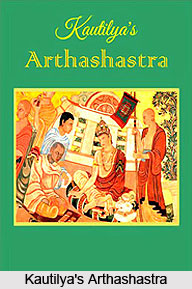 Generally subjects like Dharma, Artha and Kama were treated in a single epic but specialized schools on these subjects might have led to the origin of Arthashastra. In older system these were combined subjects as parts of Dharma in the wider sense. The Dharma sutras deal with royal duties, capitals and countries, officials, taxes and military preparations, justice as well as list the authorities of the science of kings.
Generally subjects like Dharma, Artha and Kama were treated in a single epic but specialized schools on these subjects might have led to the origin of Arthashastra. In older system these were combined subjects as parts of Dharma in the wider sense. The Dharma sutras deal with royal duties, capitals and countries, officials, taxes and military preparations, justice as well as list the authorities of the science of kings.
Brhadaranyaka Upanishad shows that a wide knowledge of love was prevalent in Brahmanical circles. Gradually schools might have sprung up who studied Artha and Kama in themselves. This has been confirmed by the Smritis and the epics.
The Mahabharata reveals that Brahman, the creator was the author of a work in 100,000 sections on the three topics. Shiva as Vishalaksa reduced it to 10, due to the terseness in life. Indra brought it down to 5,000 called Bdhudantaka. It was reduced by Brihaspati to 3,000 and by Ushanas to 1,000. Kautilya`s Arthashastra states that Brihaspati, Bahudantiputra, Vishalaksa and Ushanas are authorities. The Kama sutra attributes Dharma to Manu, Artha to Brihaspati and Kama to Nandin.
The epic contains sections which deal with polity. One may find traces of actual use of Arthashastra in one or two passages. The Smritis of Manu, Yajnavalkya and Lord Vishnu made use of texts of this type in compiling their contents. It has been seen that Dharma texts are ideal as compared to the Arthashastra. The texts of Dharma deal with duty and morality as the foundation of law. The Arthashastra deals with profit and shows no concern for religion or duty. It can use the former to advance the interest of the prince. The latter is good policy to win popular affection. Nevertheless Arthashastra or as called Nitishastra, science of conduct, Rajniti, conduct of kings, or Dandaniti, policy of punishment, was respected by all poets who lived in royal courts.
Bhasa in his Pratijndyaugandhard-yana and Pratitnandtaka, Kalidasa, Bharavi, Magha, and their followers show their ability in Niti as in Kama. Brhaspati in the epic is the founder of the science. Bhasa cites a Barhaspatya Arthashastra as an entity of study by Brahmins.



















